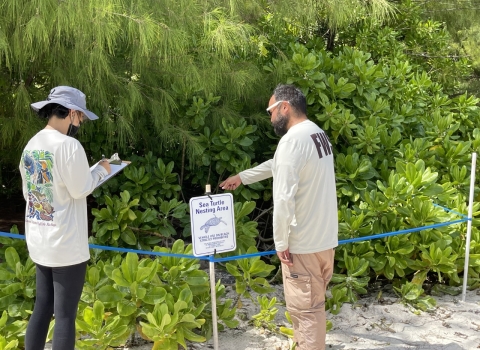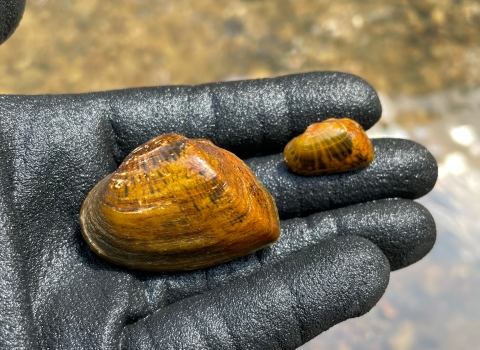The Biden-Harris Administration today submitted to Congress the President’s Budget for fiscal year 2023. The President’s Budget details his vision to expand on the historic progress our country has made over the last year and deliver the agenda he laid out in his State of the Union address—to build a better America, reduce the deficit, reduce costs for families, and grow the economy from the bottom up and middle out.
The Biden-Harris Administration is proposing a budget of $2.0 billion for Fiscal Year 2023 to fund the U.S. Fish and Wildlife Service’s principal resource management and conservation programs that support the Administration’s priorities.
The budget makes critical investments in the American people that will help lay a stronger foundation for shared growth and prosperity for generations to come. The discretionary request of $2.0 billion is an increase of $388.2 million over the 2022 Continuing Resolution level. The Service also receives $1.8 billion in permanent appropriations, most of which is provided to states for fish and wildlife conservation and restoration.
“President Biden has proposed an important blueprint for our country’s future that reflects the importance of science, equity and collaboration in carrying out Interior’s important missions,” said Secretary Deb Haaland. “These resources, coupled with the historic Bipartisan Infrastructure Law Bipartisan Infrastructure Law
The Bipartisan Infrastructure Law (BIL) is a once-in-a-generation investment in the nation’s infrastructure and economic competitiveness. We were directly appropriated $455 million over five years in BIL funds for programs related to the President’s America the Beautiful initiative.
Learn more about Bipartisan Infrastructure Law , will help the Department make critical investments in climate resiliency while creating good-paying union jobs in the clean energy economy, ensuring Tribal communities have the resources and support they need, and conserving and protecting wildlife and their habitats for future generations. Together, we can ensure that every community has a stake in our efforts to build a better America.”
The Service’s budget proposal reflects the Department of the Interior’s priorities, including implementing the Administration’s America the Beautifulinitiative, with investments to address the effects of climate change climate change
Climate change includes both global warming driven by human-induced emissions of greenhouse gases and the resulting large-scale shifts in weather patterns. Though there have been previous periods of climatic change, since the mid-20th century humans have had an unprecedented impact on Earth's climate system and caused change on a global scale.
Learn more about climate change on Service trust resources, conserve species and habitats, reconnect Americans with the outdoors, enable economic development, and create good-paying job opportunities.
“The Biden-Harris Administration’s FY 2023 budget makes important investments in conservation that help protect our cherished wildlife and natural resources as well as jobs and communities,” said Service Director Martha Williams. “This budget strengthens the Service’s foundational priorities, enhances our ability to address climate change, and ensures wildlife and habitat conservation.”
America the Beautiful -- The proposed FY 2023 budget supports agency priorities historically central to the Service’s mission and Administration initiatives that leverage the agency’s work. For example, the Biden-Harris Administration’s America the Beautiful initiative is a call to action to support locally led conservation and restoration efforts across public, private, state and Tribal lands and waters to collectively conserve, connect and restore 30 percent of U.S. land and water by 2030. The guiding principles—which include a commitment to collaboration, support for voluntary and locally led conservation, and honoring of Tribal sovereignty and private property rights—are essential to building and maintaining broad support, enthusiasm and trust. Upholding these principles, the 2023 budget includes increases to support local partnership programs, improve targeted conservation efforts, restore damaged lands, and promote locally led efforts of all kinds wherever communities wish to safeguard the lands and waters they know and love.
Additional funding will be used to support land management and restoration, collaboration with states, Tribes and private landowners to conserve habitat while supporting working lands, and engaging urban communities in conservation. For example, the budget enables the Service to work alongside private landowners by investing $83.4 million in the Partners for Fish and Wildlife and Coastal programs. It also includes $82.4 million for State and Tribal Wildlife Grants, an increase of $10 million to support state and Tribal efforts to protect wildlife habitat.
Conservation – Conservation is at the heart of the Service’s mission, and The National Wildlife Refuge System is a model for conservation around the world. The request for the Refuge System is $597.9 million. These investments will create job opportunities for Americans in the outdoors and through increased project consultation capacity to simultaneously support conservation and economic development.
In addition, the budget request includes $356.2 million to further the conservation of species listed under the Endangered Species Act and work to prevent at-risk species from becoming further imperiled. It also includes $260.4 million for the Fish and Aquatic Conservation program and builds on support in the Bipartisan Infrastructure Law with $2.6 million to establish an aquatic invasive species invasive species
An invasive species is any plant or animal that has spread or been introduced into a new area where they are, or could, cause harm to the environment, economy, or human, animal, or plant health. Their unwelcome presence can destroy ecosystems and cost millions of dollars.
Learn more about invasive species rapid response initiative. The budget includes $70.2 million to advance the migratory bird program.
Climate Change – The Service is focusing on climate change across all of its programs. The Service’s Science Applications activity, consisting of Cooperative Landscape Conservation and Science Support programs, works with partners in developing plans to conserve landscapes across the country to address climate change as well as other conservation needs. The Service is requesting a total of $57.5 million for these programs.
Deploying Clean Energy – The budget proposes $27.6 million for activities associated with energy development, including a program increase of $8 million for the Ecological Services Planning and Consultation program to support reviews and permitting of clean energy projects. Within the Migratory Bird Management program, the budget includes program increases totaling $8 million to support clean energy projects and other permitting improvements to ensure renewable resources can be deployed while protecting migratory birds, notably iconic bald and golden eagles.
The Service recognizes the need to support the development of clean energy sources to create new industries to support American workers while reducing emissions that contribute to climate change.
Promoting Equity and Diversity– Additionally, the budget request for the Service includes $1.9 million to promote Diversity, Equity, Inclusion, and Accessibility, including $560,000 as part of a Department of the Interior-wide budget initiative to address high-priority needs in support of Executive Order 13985, Advancing Racial Equity and Support for Underserved Communities Through the Federal Government, and Executive Order 13988, Preventing and Combating Discrimination on the Basis of Gender Identity and Sexual Orientation.
The Budget makes these smart investments while also reducing deficits and improving our country’s long-term fiscal outlook.
For more information on the President’s FY 2023 Budget, please visit: https://www.whitehouse.gov/omb/budget/.
For more information on the Service’s FY 2023 Budget, please visit: https://doi.gov/budget/appropriations/2023
The Department of the Interior oversees one-fifth of the nation’s land and the entire Outer-Continental Shelf. The Department is charged with overseeing energy development on federal lands and waters, grazing allotments and timber sales, water conservation and delivery, upholding tribal trust responsibilities, conservation of wildlife and habitat, and maintaining access for recreation throughout public lands, among other priorities. With this budget, the Service is able to effectively fulfill its mission and address conservation priorities.
The mission of the U.S. Fish and Wildlife Service is working with others to conserve, protect and enhance fish, wildlife, plants and their habitats for the continuing benefit of the American people. We are both a leader and trusted partner in fish and wildlife conservation, known for our scientific excellence, stewardship of lands and natural resources, dedicated professionals and commitment to public service. For more information on our work and the people who make it happen, visit http://www.fws.gov/. Connect with our Facebook page, follow our tweets, watch our YouTube Channel and download photos from our Flickr page.



